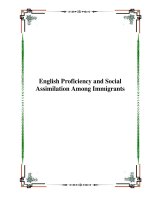English Be and have
Bạn đang xem bản rút gọn của tài liệu. Xem và tải ngay bản đầy đủ của tài liệu tại đây (15.71 KB, 1 trang )
Be and have
To talk about experiencing physical sensations like hunger, thirst, heat and cold, we use the structure
be +
adjective
.
Feel + adjective
is also possible. Note that we do not usually use
have + noun
to express these
ideas.
I
am
hungry. (NOT I have hunger.)
Are
you thirsty? (NOT Do you have thirst?)
Are
you warm enough?
I
am
sleepy.
I
am
afraid.
I
feel
hungry.
I
feel
fine.
I
feel
cold.
Note also the expressions:
Be right, be wrong and be lucky.
You
are
right.
He
is
lucky.
Am
I wrong?
Height, weight, age, size and color
Be
, and not
have
, is used to talk about height, weight, age, size and color.
She
is
nearly forty. (NOT She has nearly forty.)
Her eyes
are
blue. (NOT Her eyes have blue.)
My brother
is
six feet tall. (NOT My brother has six feet height.)
She
is
the same height as her husband.
What size
are
your shoes?
I wish I
was
a few inches taller.
I wish I
was
a few kilos lighter.
Note that in measuring expressions we do not use
be heavy
.
She weighs forty-eight kilos. (NOT She is forty-eight kilos heavy.)
Note on the verb weigh
Weigh
is one of those verbs which are not normally used in the progressive form.
I
weighed
fifty-six kilos two months ago. (NOT I was weighing fifty-six kilos two months ago.)
However,
weigh
can be used in the progressive form when it does not mean ‘have weight’.
The scales broke when she
was weighing
herself the other day.
Be first to know when grammar rules change! Sign up to our newsletter here: englishgrammar.org (It's free)
Powered by TCPDF (www.tcpdf.org)









